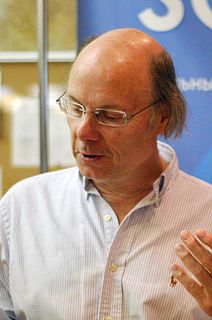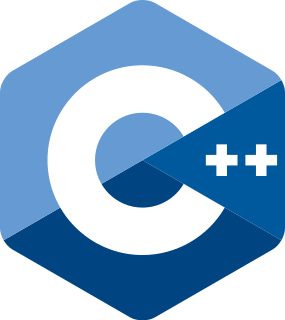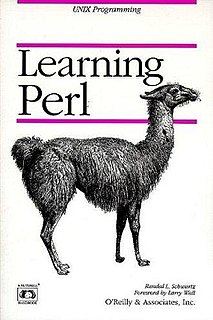
Bjarne Stroustrup is a Danish computer scientist, most notable for the invention and development of the C++ programming language. He is a visiting professor at Columbia University, and works at Morgan Stanley as a managing director in New York.
In imperative programming, a computer program is a sequence of instructions in a programming language that a computer can execute or interpret. In declarative programming, a computer program is a set of instructions.

Lisp is a family of programming languages with a long history and a distinctive, fully parenthesized prefix notation. Originally specified in 1958, Lisp is the second-oldest high-level programming language still in common use. Only Fortran is older, by one year. Lisp has changed since its early days, and many dialects have existed over its history. Today, the best-known general-purpose Lisp dialects are Racket, Common Lisp, Scheme, and Clojure.
PostScript (PS) is a page description language in the electronic publishing and desktop publishing realm. It is a dynamically typed, concatenative programming language. It was created at Adobe Systems by John Warnock, Charles Geschke, Doug Brotz, Ed Taft and Bill Paxton from 1982 to 1984.
The waterfall model is a breakdown of project activities into linear sequential phases, where each phase depends on the deliverables of the previous one and corresponds to a specialization of tasks. The approach is typical for certain areas of engineering design. In software development, it tends to be among the less iterative and flexible approaches, as progress flows in largely one direction through the phases of conception, initiation, analysis, design, construction, testing, deployment and maintenance.

C++ is a general-purpose programming language created by Bjarne Stroustrup as an extension of the C programming language, or "C with Classes". The language has expanded significantly over time, and modern C++ now has object-oriented, generic, and functional features in addition to facilities for low-level memory manipulation. It is almost always implemented as a compiled language, and many vendors provide C++ compilers, including the Free Software Foundation, LLVM, Microsoft, Intel, Oracle, and IBM, so it is available on many platforms.

Structure and Interpretation of Computer Programs (SICP) is a computer science textbook by Massachusetts Institute of Technology professors Harold Abelson and Gerald Jay Sussman with Julie Sussman. It is known as the Wizard Book in hacker culture. It teaches fundamental principles of computer programming, including recursion, abstraction, modularity, and programming language design and implementation.
ECMAScript is a JavaScript standard meant to ensure the interoperability of web pages across different web browsers. It is standardized by Ecma International according to the document ECMA-262. ECMAScript is commonly used for client-side scripting on the World Wide Web, and it is increasingly being used for writing server applications and services using Node.js.

The C Programming Language is a computer programming book written by Brian Kernighan and Dennis Ritchie, the latter of whom originally designed and implemented the language, as well as co-designed the Unix operating system with which development of the language was closely intertwined. The book was central to the development and popularization of the C programming language and is still widely read and used today. Because the book was co-authored by the original language designer, and because the first edition of the book served for many years as the de facto standard for the language, the book was regarded by many to be the authoritative reference on C.

Learning Perl, also known as the llama book, is a tutorial book for the Perl programming language, and is published by O'Reilly Media. The first edition (1993) was authored solely by Randal L. Schwartz, and covered Perl 4. All subsequent editions have covered Perl 5. The second (1997) edition was coauthored with Tom Christiansen and the third (2001) edition was coauthored with Tom Phoenix. The fourth (2005), fifth (2008), sixth (2011), and seventh (2016) editions were written by Schwartz, Phoenix, and brian d foy. According to the 5th edition of the book, previous editions have sold more than 500,000 copies.

The Free Library of Philadelphia is the public library system that serves Philadelphia. It is the 13th-largest public library system in the United States. The Free Library of Philadelphia is a non-Mayoral agency of the City of Philadelphia governed by an independent Board of Trustees as per the Charter of the City of Philadelphia. The Free Library of Philadelphia Foundation is a separate 501c3 non-profit with its own board of directors and serves to support the mission of the Free Library of Philadelphia through philanthropic dollars.

Sixth Edition Unix, also called Version 6 Unix or just V6, was the first version of the Unix operating system to see wide release outside Bell Labs. It was released in May 1975 and, like its direct predecessor, targeted the DEC PDP-11 family of minicomputers. It was superseded by Version 7 Unix in 1978/1979, although V6 systems remained in regular operation until at least 1985.
In object-oriented programming, inheritance is the mechanism of basing an object or class upon another object or class, retaining similar implementation. Also defined as deriving new classes from existing ones such as super class or base class and then forming them into a hierarchy of classes. In most class-based object-oriented languages, an object created through inheritance, a "child object", acquires all the properties and behaviors of the "parent object", with the exception of: constructors, destructor, overloaded operators and friend functions of the base class. Inheritance allows programmers to create classes that are built upon existing classes, to specify a new implementation while maintaining the same behaviors, to reuse code and to independently extend original software via public classes and interfaces. The relationships of objects or classes through inheritance give rise to a directed acyclic graph.

Introduction to Algorithms is a book on computer programming by Thomas H. Cormen, Charles E. Leiserson, Ronald L. Rivest, and Clifford Stein. The book has been widely used as the textbook for algorithms courses at many universities and is commonly cited as a reference for algorithms in published papers, with over 10,000 citations documented on CiteSeerX. The book sold half a million copies during its first 20 years. Its fame has led to the common use of the abbreviation "CLRS", or, in the first edition, "CLR".

Robin Patricia Williams is an American educator who has authored many computer-related books, as well as the book Sweet Swan of Avon: Did a Woman Write Shakespeare?. Among her computer books are manuals of style The Mac is Not a Typewriter and numerous manuals for various macOS operating systems and applications, including The Little Mac Book.
conio.h is a C header file used mostly by MS-DOS compilers to provide console input/output. It is not part of the C standard library or ISO C, nor is it defined by POSIX.
Herbert Schildt is an American computing author, programmer and musician. He has written books about various programming languages. He was also a founding member of the progressive rock band Starcastle.

Rust is a multi-paradigm, general-purpose programming language designed for performance and safety, especially safe concurrency. Rust is syntactically similar to C++, but can guarantee memory safety by using a borrow checker to validate references. Rust achieves memory safety without garbage collection, and reference counting is optional. Rust has been called a systems programming language, and in addition to high-level features such as functional programming it also offers mechanisms for low-level memory management.

Structure and Interpretation of Computer Programs, JavaScript Edition is an adaptation of the computer science textbook Structure and Interpretation of Computer Programs (SICP). It teaches fundamental principles of computer programming, including recursion, abstraction, modularity, and programming language design and implementation. While the original version of SICP uses the programming language Scheme, this edition uses the programming language JavaScript.
Schildts & Söderströms is a Finnish book publisher, which was established in February 2012 through a merger between Schildts Förlags Ab and Söderström & Co.












